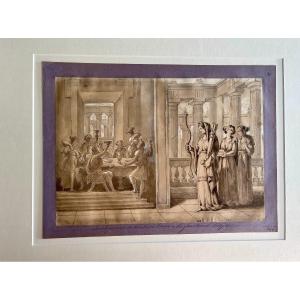"Very Rare Pair Of Wooden Ceremonial Angels - Siena, 16th Century"
The Siena School of 16th-century sculpture is an important Italian artistic tradition that is part of the long history of Sienese art, renowned for its wealth and influence, particularly during the Renaissance. Context and Influence The Siena School has its roots in the city of Siena in Tuscany, a region of great artistic importance during the Renaissance. While Florence dominated the art scene with figures such as Michelangelo and Donatello, Siena developed its own distinctive aesthetic, marked by a more ornamental and elegant style. Although the Siena School is often associated with painting, sculpture also underwent significant development, particularly in the 16th century. Characteristics of 16th-Century Sienese Sculpture Sienese sculptors of the 16th century continued to develop a style that combined the Gothic elegance of their predecessors with the influence of Renaissance classicism. Unlike Florentine works, which were often more rigorous and muscular, Sienese sculptures are known for their refinement, expressiveness, and sensitivity to ornamental detail. Materials and Techniques: Wood was a frequently used material, often polychromed, which allowed the expressive details of the figures to be accentuated. Sienese sculptors excelled in surface work, giving the works a smooth and meticulously worked finish. Themes: The sculptures of the School of Siena often depicted religious subjects, including figures of saints, angels, and the Virgin Mary. Spirituality and devotion permeated these works, aiming to create a strong visual connection with the divine. Style: The Sienese style of sculpture is distinguished by elongated, graceful forms, with a certain delicacy in the postures and facial expressions. The influence of the late Gothic remained present in the attention to detail, the flowing draperies, and the delicately modeled faces. Important Artists The Sienese 16th century saw the emergence of influential sculptors such as Domenico Beccafumi, best known for his painting but who also influenced sculpture with his use of light and colour. The transition from the late Gothic to the Sienese Renaissance thus produced a unique synthesis, where medieval spirituality was fused with resurgent humanism. Legacy The School of Siena has left a lasting legacy, particularly visible in the preservation of numerous altarpieces, religious statues and church ornaments throughout Tuscany. Although often less celebrated than that of Florence, the School of Siena is recognised for its singular aesthetic, attention to detail and continuing influence on religious art in Italy. Today, 16th-century Sienese sculptures are prized for their rarity and beauty, often held in museums or private collections.
*******************************************************
Discover this very rare pair of cerophore angels from a beautiful Tuscan residence. Carved in wood and polychromed, these angels are an exquisite testimony to the 16th century Siena School. With their carefully crafted details and their imposing dimensions (64 x 24 x 14 cm), they add a touch of majesty and spirituality to any interior or collection. Despite some natural wear and minor losses to the polychromy, probably later, these pieces remain in good condition for their age. Their strong presence and their old charm testify to the exceptional know-how of the Sienese master sculptors of the Renaissance.
Features: Pair of cerophore angels Siena School, 16th century Carved and polychromed wood
Dimensions: 64 x 24 x 14 cm
Good condition for age and use Some lacks, wear to the polychromy
Shipping: Very careful shipping, with packaging adapted to the fragility of these works of art.
#RenaissanceArt #SienaSchool #Antiques #CerophoreAngels #WoodenSculpture #SacredArt #ItalianRenaissance #ArtCollector #TuscanAntiques #Collectibles #ArtHistory


















































 Le Magazine de PROANTIC
Le Magazine de PROANTIC TRÉSORS Magazine
TRÉSORS Magazine Rivista Artiquariato
Rivista Artiquariato